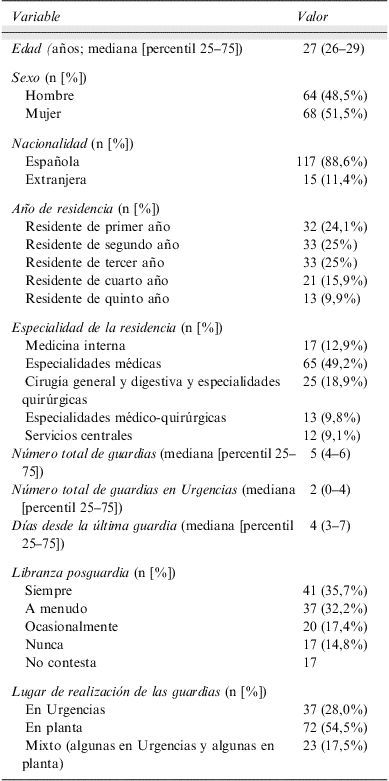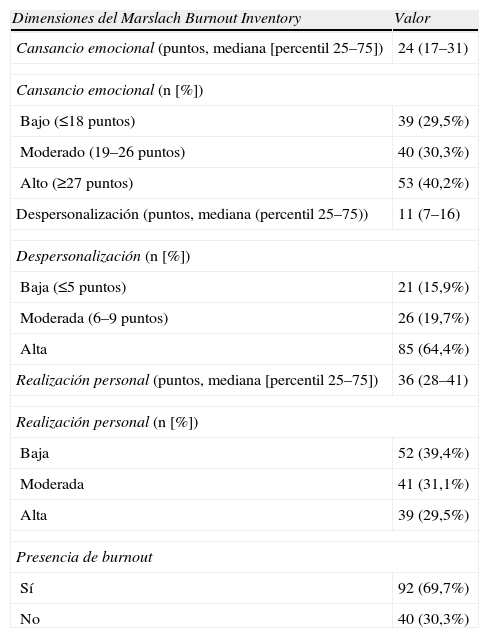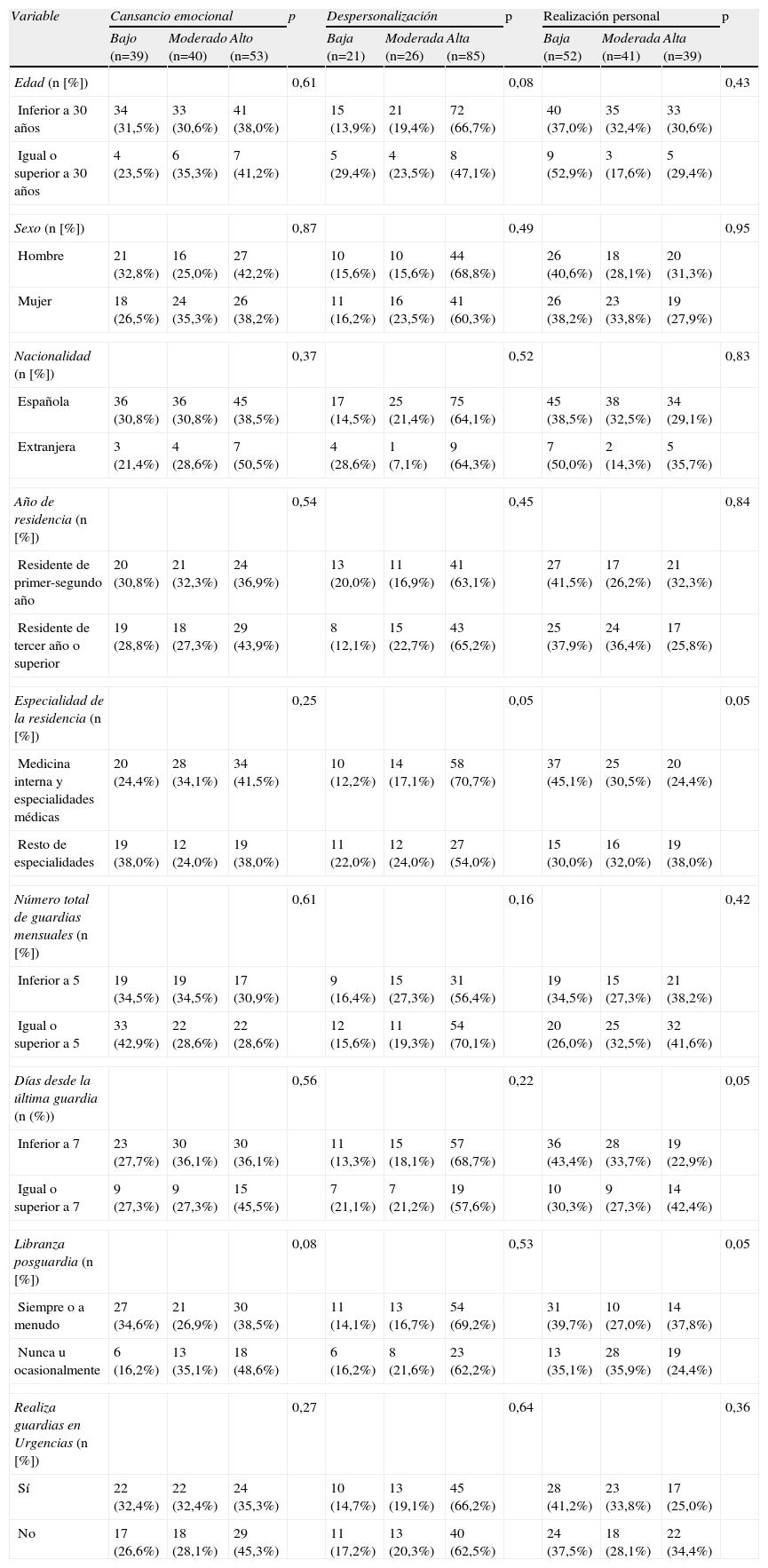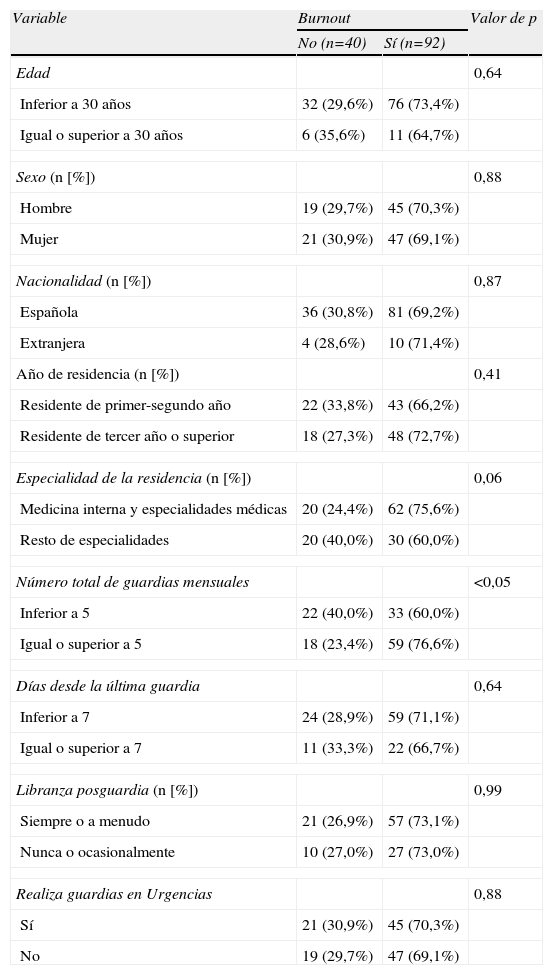Investigar el grado de burnout entre los residentes de un hospital universitario y los factores asociados al mismo.
Material y métodoSe envió a todos los residentes el Maslach Burnout Inventory que valora cansancio emocional, despersonalización y realización personal. Existe burnout ante un grado de cansancio emocional o de despersonalización altos. Se consignaron variables epidemiológicas (edad, sexo, nacionalidad, año de residencia, especialidad, número de guardias totales y en urgencias, días postguardia, libranza postguardia, posición de guardia). Se investigó la relación de estas con la puntuación en las dimensiones del Maslach Burnout Inventory con el burnout (chi cuadrado) y la asociación con el número de guardias (regresión lineal).
ResultadosContestaron 132 de 290 residentes (45,5%): el 40,2% presentaba un alto cansancio emocional y el 64,4% una alta despersonalización. En total, el 69,7% de los residentes presentaba burnout. No existieron asociaciones estadísticamente significativas entre las variables epidemiológicas y las dimensiones del Maslach Burnout Inventory. El número total de guardias se relacionó significativamente con el cansancio emocional (p<0,05), sin relación con las guardias en Urgencias. La realización de 5 o más guardias al mes condicionó burnout con mayor frecuencia (76,6 vs.60,0%, p<0,05). Se observó una tendencia a un mayor burnout entre los residentes de medicina interna y especialidades médicas con respecto al resto (75,6 vs. 60,0%, p=0,05).
ConclusionesLa prevalencia de burnout entre los residentes es elevada y se relaciona fundamentalmente con el número de guardias realizadas.
To investigate the degree of burnout among resident physicians of a university hospital and the factors associated with it.
Materials and MethodsMaslach burnout Inventory (MBI) was sent to all residents, which assesses emotional exhaustion, depersonalization and personal accomplishment. Burnout exists when high degree of emotional exhaustion or depersonalization are obtained. Several variables were analyzed (age, sex, nationality, year of residency, speciality, total monthly calls and in emergency departments, days since last call, duty-free day after calls, position at calls). It′s relationship with the score on the different dimensions of MBI and burnout was analyzed through the test of the chi-square, whereas the association between scores of MBI and the number of calls were analyzed using linear regression.
Results132 of 290 residents answered (45.5%): 40.2% had a high emotional exhaustion and a 64.4% presented depersonalization. In total, 69.7% of the residents had burnout. There was no statistically association between the epidemiological variables and the different dimensions of the MBI. The total number of calls per month were significantly associated with emotional exhaustion (p<0.05). There wasn’t any relation to the number of calls in emergency departments. Resident physicians who had 5 or more calls per month showed burnout more often than the rest (76.6% versus 60.0%, p<0.05). A trend towards a higher burnout was present among residents of Internal medicine and medical specialities than the rest (75.6% versus 60.0%, p=0.05).
ConclusionsThe prevalence of burnout among the group of residents is high and relates mainly to the monthly number of calls
Artículo
Diríjase desde aquí a la web de la >>>FESEMI<<< e inicie sesión mediante el formulario que se encuentra en la barra superior, pulsando sobre el candado.

Una vez autentificado, en la misma web de FESEMI, en el menú superior, elija la opción deseada.

>>>FESEMI<<<











